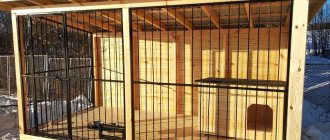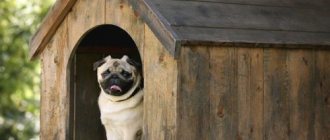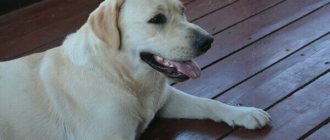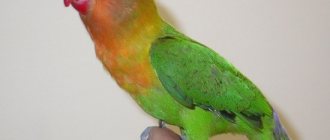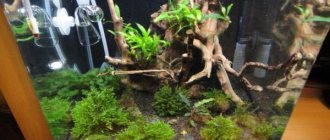Is Labrador Retriever Suitable for Outdoor Living?
The Labrador is a playful and active dog, it belongs to the hunting breeds and can quite easily adapt to environmental conditions. Therefore, breeders answer positively the question whether it is possible to keep a Labrador on the street. The pet will be comfortable both in the apartment and in the yard. However, you can’t just let your dog roam free; you should take care of the following points:
- A spacious and safe enclosure from which the animal cannot escape.
- A warm booth suitable for the size of the dog.
- Toys that your pet can use to entertain himself.
Important! The Labrador is not intended for home protection; it is not a guard dog.
How to teach cleanliness
Labrador retrievers should be taught to be clean from the very first days. This will require a lot of strength and patience, but in general the animal is understanding and loves praise.
You need to choose a suitable place for the toilet; a tray with a low edge is suitable for this.
Puppies usually go to the toilet after changing their activities. This could be sleeping, playing or eating.
You can only walk outside with a vaccinated puppy. Therefore, you need to take care of comprehensive vaccination.
The first walk can be stressful, but this is not a reason to keep your dog indoors all the time. Be sure to use a leash and collar, then the animal will not run away.
When using the elevator, you should be careful that the puppy does not end up on the other side of the doors. Initially, walks will be just an excursion, an acquaintance with an unknown world.
At first, you need to walk outside for no more than twenty minutes, then the time can be gradually increased.
By six months, the puppy may be exposed to long periods of walking and jumping over obstacles.
It is not necessary to keep him on a leash all the time, but then you should choose a suitable place to play. There is no need to allow long descents from the stairs.
Then all the limbs will be correctly positioned and the spine will be straight, which is very important for dogs of this breed
Optimal temperature range
Adaptation of the breed to different types of keeping is a great advantage of these dogs, however, they need to be accustomed to life at home or on the street from childhood. Moreover, it is not recommended to change the place of residence, so as not to cause stress to the animal. Temperatures below 10-15 °C are considered critical for their body. Therefore, Labrador usually remains outside in the summer, spring-autumn, or at any time if the area is warm all year round.
The individual health characteristics of dogs are of great importance: some do not tolerate even -3 °C well, others are comfortable even at -15 °C. In particular, old dogs or those who are often ill, as well as pregnant and lactating females, are moved into the house.
Attention! Can a Labrador live outside in winter - the answer is “yes” if it is relatively warm and mild in the region.
Condominium for a friend
Over the past hundred years, the functions that dogs perform in our lives have changed greatly. Now even representatives of large breeds are often kept as pets, although not so long ago they performed strictly “working”, applied tasks: guarding houses, hunting, herding livestock.
The transformation of the dog from a “servant” to a full-fledged companion has had a beneficial effect on our relationship with him. The friendship between a dog and a person served as the basis for revealing the best traits of a dog’s character: devotion, camaraderie. Selection also played a role: a balanced character and excellent communication qualities have long been included in breed standards, and animals possessing them are selected for breeding. Labradors are a striking example: they are sociable, active, devoid of aggression towards people, such a dog is a suitable option for keeping in the house.
It is a common belief that a companion dog should be kept in an apartment, closer to oneself, and kennel life is for working shepherd dogs that guard warehouses and enterprises. This is not necessarily the case. If you live in a private house and you have the opportunity to equip your Labrador with a comfortable enclosure and an insulated booth, you can keep him outside.
Limitations and features of living on the street
Can a Labrador live outside? Yes, and there are some specifics to street content:
- The animal will be able to show its curiosity and satisfy the need for activity.
- The Labrador will shed naturally without filling the person's home with fur.
- If a pet lives on the street, it will not be able to spoil the household’s belongings.
However, do not forget about the restrictions of living on the street:
- An animal may become bored without the constant presence of its owner.
- To constantly be outside, you need to be in good health - the animal is more susceptible to negative environmental factors.
- Labrador requires the creation of suitable external conditions, at least a kennel.
You need to walk your dog regularly, even if it lives on the street.
Breeding
Only pedigree Labradors participate in breeding in accordance with the plan drawn up by the club. At the age of two years, dogs undergo an admission test. This check should reveal defects that do not allow participation in breeding.
Conditions for admission to the test:
- age from 2 to 5 years;
- pedigree;
- participation in at least 3 exhibitions. Ratings not lower than “Very good”;
- passed training and endurance exams;
- X-rays confirming the absence of joint dysplasia;
- documents for identifying a male dog;
- document confirming testing for hemophilia;
- written confirmation from the owner that he is not aware of any hidden defects in the Labrador.
Test results are valid for 3 years.
If a Labrador is found to be defective in color, eye color, cryptorchidism, malocclusion, etc., sterilization is indicated. These dogs are not allowed to participate in exhibitions or breeding. The price of such puppies is much lower. Consider this option if you are not planning offspring and fame for your dog.
What does it take to make your pet comfortable?
Dog breeders recommend purchasing both a home and an enclosure for your Labrador if he lives on the street.
Aviary
A classic enclosure is a wooden or metal structure resembling a fence. It usually has 4 walls, one of which can open. If necessary, a floor is made in the enclosure. Bowls with food and water must be placed inside.
Booth
A booth is a rectangular enclosed space with walls, a floor, a roof and an entrance. It is built to the size of a specific animal, and unlike an enclosure, it has a small area. For its production, environmentally friendly materials such as wood are used (analogue - plywood).
Working on the walls
The next stage is making the walls. To begin with, the frame is traditionally assembled - for this, use the same bars. But they should be fixed to the bottom frame with longer screws. Better yet, use reliable corners. Then the rigidity of the structure will be maximum. At the same time, remember that on one side the bars should be higher, and the upper end should be cut at an angle - this will ensure a tight fit of the roof and at the same time guarantee the desired angle of the roof slope.
Now you need to line the inside walls with plywood or clapboard. The latter option is preferable - there will be no splinters here, which means that your pet will be much more comfortable living in the booth. Before covering the outside (here plywood can be used as a cheaper material), additional thermal insulation can be provided. The gap between the inner and outer cladding can be filled with suitable material - foam boards or ordinary small sawdust.
The casing should be secured with short self-tapping screws. Make sure that the caps are tightly recessed, but that the sharp ends of the screws do not stick out inside.
Which is better - a booth or an aviary?
Beginners wonder whether it is possible to keep a Labrador in an enclosure. We can definitely agree with this, since an outdoor corral has a number of advantages:
- Spacious.
- Fresh air.
- The opportunity to play and spend time much more actively than indoors.
- A good addition to periodic walks.
A significant disadvantage of such a fence is that the animal has nowhere to hide from rain and wind, as well as bright sun, unless there is a dwelling with a roof nearby.
The booth has the following advantages:
- This is a comfortable and safe place, a secluded corner that any animal periodically needs.
- You can sleep and relax in it.
- It protects well from bad weather.
There should be enough free space next to the kennel for the dog to move around. In this regard, a private house with a plot of land is convenient.
Important! A dog such as a Labrador is prohibited from being kept on a chain. Tethering is permitted only when necessary.
The pet should have not only an open enclosure, but also a booth
Advantages
An enclosure for a husky is a necessary item in a private household.
An active, but freedom-loving animal should have the opportunity for independent games and activities, and not languish on a chain in the periods between rare walks.
Living outside in a personal space will relieve the dog from the disturbing presence of other types of pets, heat in the rooms, and noise.
Living outside, but in comfortable conditions, maintains the health of the animal and allows it to adapt to climatic conditions.
Considering the fact that the Laika is a hunting dog and spends several days in the forest, it will be prepared for the upcoming loads.
For the owner, keeping the dog separate will ensure that the animal gets rid of fur on the furniture, barking during off-hours, and conflicts with cats.
Often, when guests visit, the dog has to be locked in other rooms, which embarrasses and disturbs the household.
Being in an enclosure with a walking area will reduce the time of additional walks, because the dog will be able to frolic and play independently.
Aviary for Labrador
You can buy a pen for your pet or make it yourself.
Purchased aviary
You need to carefully choose the area of the fence: it should be an area of 8 square meters. meters; the width is 1.5 times greater than the animal’s body, and the height is such that the dog can fully stand on its hind legs in the enclosure.
Self-construction
When manufacturing independently, high-quality, strong and reliable materials are used. So, a steel pipe is suitable for the frame. The back walls are made of wood, and the front walls are made of round or square rods. All materials are treated with protective agents against rotting and fungus.
Important! Before construction, be sure to create a design drawing with all calculations.
Aviary care
Labradors are not the cleanest dogs, so systematic cleaning of their habitat is very important: the enclosure is cleared of excrement. You also need to monitor the condition of the walls, floors and fixtures, as they can become unusable due to adverse weather or exposure to dogs. If necessary, they are repaired or replaced with new ones.
Comfortable conditions for living in an enclosure
The pen should be located so as to provide the dog with sufficient visibility of the yard. It is advisable to choose a dry site located slightly on a hill next to the entrance to the house. You should not place objects with a strong smell near the enclosure; it is also not recommended to decorate the fence with flower beds. The animal in the enclosure must have access to food and water.
Installation required
Many owners are embarrassed by the prospect of locking their pets within four walls, but letting a large breed dog into the house is not the best solution. According to dog handlers, for some breeds, keeping an enclosure is a necessary necessity. Alaskan Malamute, Tibetan Mastiff, Alabai - these breeds were created for protection; they are naturally given the need for their own guard post. Such dogs feel great when kept outdoors, even in winter, but when kept at home they cause more harm.
The ubiquity of hair, the danger of damaged furniture and interior items, and an unpleasant odor are some of the reasons why you should not keep large dogs at home. Moreover, some owners worry that the dog will be lonely on the street. This is absolutely not true. Of course, he will be glad to communicate, but he will never feel limited or locked in. Dogs, having gotten used to new conditions, perceive it as their territory.
Now there is a large selection of ready-made enclosures for dogs, but many people strive to make them with their own hands. For some, the standard design is not suitable, while for others its price is not suitable. Some people themselves want to arrange their pet’s home so that it is as comfortable as possible. The cost of the finished product is quite high, but the materials are not cheap now. And in order to build a high-quality enclosure you need to have some skills. You may not always have all the necessary equipment and tools at hand at home, and you will have to turn to a specialist for help. Before you start creating a home enclosure for dogs with your own hands, you should think about everything carefully and calculate it. It is possible that it is better to do only part of the work yourself, and let specialists perform other more complex workpieces.
Choosing a location for an outdoor enclosure for a dog. In the northern regions they are located with a façade facing south, and in the southern regions, on the contrary, towards the southeast or southwest. It is necessary that it stands on a hill, and that the dog has the opportunity to hide from the sun. We select materials for making the product. It is better to choose one that is safe for your pet. When using boards, our design will be safe and reliable. One of the walls of our structure can be a ready-made wall of a garage or other building. It is best if you first sketch out a simple drawing, which will help take into account all the nuances of the future design.
Next you will need to prepare the site for construction. It is best to concrete it or lay asphalt. If this cannot be done yet, then you can cover the ground with roofing felt or put down roofing felt. Then we make a border on which we will begin to mount our structure. Its height can be approximately the size of a couple of bricks. What is it for? It is necessary to ventilate the space between the platform and the enclosure, which will allow it to be ventilated and remain as dry as possible.
Let's move on to making the floor. The most environmentally friendly and comfortable for your dog will be a wooden covering. It's warm and easy to clean. When you make an enclosure for a dog with your own hands, it is advisable to fit the boards tightly and without gaps so that the pet cannot get hurt. To prevent the floor from sagging, it is advisable to install the shield on strong supports. These can be logs or a frame specially welded from pipes.
Let's start making the walls. One or two of them need to be made solid. Wood or corrugated board is suitable for this. The rest can be built from lattice. We will make a gap between the bars of about 10 cm. Here, in the lattice, there will be the door of our enclosure.
After constructing the walls, we proceed to the roof. It can be built from any high-quality material - corrugated sheets, slate, galvanized metal, metal tiles. The main thing is that there is a slope for water drainage, so we make one wall 10-15 centimeters higher.
How to set up an enclosure for a dog? You definitely need to make a wooden one for it.
Kennel for Labrador
Booths have their own requirements.
Types of booths
Booths are divided according to different criteria:
- Material - wood, plastic, concrete or metal.
- Dimensions. The house must correspond to the size of the pet, and may have additional extensions, for example, a vestibule or an open area near the entrance.
- The roof structure is flat, two-pitch or single-pitch.
- Availability of insulation. Insulated options are equipped with a double floor, while the bottom is raised above the ground.
You can make a dog house yourself
Optimal sizes
Inside the kennel, the dog should be able to stand upright and lie down freely. Its height and depth are made equal to the height of the dog, with a margin of 10-15 cm.
Attention! A narrow booth provokes diseases of bones and joints; too large one will cool down and prevent the pet from warming up in winter.
How to insulate a booth
Materials for the kennel should be natural, most often it is hardwood. If you are planning a winter version of your home, the walls need to be made double. Between them is laid insulation in the form of sawdust, foam, which can retain heat in cold weather.
Let's sum it up
Now you know which enclosures are suitable for keeping Alabai. We looked at its dimensions, materials and features. And thanks to the visual video, you can do everything quickly with your own hands. In addition, we saw what a booth for an alabai should be like: dimensions, material, features. Now we can say that your pet will be completely satisfied with its new home. And if he lived in the house before, then it will become much easier for you too. However, the presence of an enclosure does not mean that you do not need to walk your shepherd dog and let it go outside. Without such outings, the dog will feel bad. Otherwise, an enclosure and a booth for the Alabai will make your life easier.
Why walking is important
Labradors are inquisitive, playful and active dogs. They really appreciate long walks and physical activity. They also need this for physiological reasons: representatives of this breed are prone to obesity. For companion dogs, human interaction is extremely important. Therefore, a long walk is another reason to spend time with your four-legged friend. They walk an adult 2-3 times a day, and more often with a puppy. Walks are combined with training and teaching basic commands. If possible, you should take your pet to a lake or river, as Labradors love to swim.
Tell me, how long can you walk your Labrador in winter without him getting cold?
The temperature in the city dropped to -15, we went for a long walk, after an hour he began to raise his paw, then lowered it, walked normally, and went to the toilet 20 times in 2 hours, this has never happened before, he always does it 1-2 times and a lot. We are 9 months old. Now I'm afraid to walk with him for a long time. And if you don’t go for a walk, there’s no peace from him at home. what to do?
doesn't raise his paw when he pees, still does it like a child
This means that you take small walks several times until your paws begin to tighten. We ate and after an hour we went for a walk, it’s warmer.
You can and should walk as much as possible. All domestic dogs tuck their paws at the beginning of a walk - their skin adapts to the new temperature - this is normal. And the fact that the dog began to write often, but little by little, simply means it’s time to grow up, and accordingly, mark his territory. Get used to it, you have a male, you won’t get away with one or two puddles on a walk, you’ll have to go around all the bushes or “favorite places by correspondence with friends.”)))))
Labradors usually don’t get cold; they have a good undercoat, but if you are afraid to walk for a long time, walk for at least forty minutes and keep him constantly moving. or you can wear boots for dogs to prevent their paws from freezing. about peeing, it’s true, he’s just marking my dog for an hour’s walk, he can raise his paw twenty times, my five years old.
some may not lift for up to a year, but they begin to mark from seven to eight months. Mine picked up at six months.
Labradors have a well-developed undercoat, which does not freeze in winter
Source
Features of maintenance and care
In order for an animal to have good health and mood, it needs to be provided with:
- Balanced diet. This can be a diet made from natural products, special dry food, as well as various vitamin bones and sticks.
- Timely walks.
- Periodic bathing as soiled. It is permissible to use only dog shampoo.
- Coat care – combing and brushing several times a week, preferably with a special brush. Labradors are not usually trimmed.
- Ear care – inspection for parasites and cleaning.
- Trimming nails, provided that they are not sharpened and interfere with the dog’s movement.
- The pet must undergo a course of vaccinations.
Labradors require special care
. Important! Labradors often have allergies, develop mastitis, and are at risk of strokes and collapse. Therefore, all large dogs are observed by a doctor.
From the above, we can already draw conclusions about whether it is possible to keep a Labrador outdoors. Both living at home and living in the yard have their pros and cons. In both cases, the dog needs to create suitable conditions for a comfortable life.
Tell me, how long can you walk your Labrador in winter without him getting cold?
The temperature in the city dropped to -15, we went for a long walk, after an hour he began to raise his paw, then lowered it, walked normally, and went to the toilet 20 times in 2 hours, this has never happened before, he always does it 1-2 times and a lot. We are 9 months old. Now I'm afraid to walk with him for a long time. And if you don’t go for a walk, there’s no peace from him at home. what to do?
doesn't raise his paw when he pees, still does it like a child
This means that you take small walks several times until your paws begin to tighten. We ate and after an hour we went for a walk, it’s warmer.
You can and should walk as much as possible. All domestic dogs tuck their paws at the beginning of a walk - their skin adapts to the new temperature - this is normal. And the fact that the dog began to write often, but little by little, simply means it’s time to grow up, and accordingly, mark his territory. Get used to it, you have a male, you won’t get away with one or two puddles on a walk, you’ll have to go around all the bushes or “favorite places by correspondence with friends.”)))))
Labradors usually don’t get cold; they have a good undercoat, but if you are afraid to walk for a long time, walk for at least forty minutes and keep him constantly moving. or you can wear boots for dogs to prevent their paws from freezing. about peeing, it’s true, he’s just marking my dog for an hour’s walk, he can raise his paw twenty times, my five years old.
some may not lift for up to a year, but they begin to mark from seven to eight months. Mine picked up at six months.
Main causes of premature death
The most common causes of death among Labradors are:
- Gastric volvulus. This is an acute dilatation of the stomach due to weakness of its wall. The disease is characterized by an increase in the size of the stomach (bloating), which entails compression of the diaphragm and impaired circulation in the internal organs, which leads to death.
- Tracheal collapse is a chronic disease with common causes. It is characterized by a narrowing of the lumen of the air tube that connects the larynx and lungs (trachea).
- Tumor of the spleen and its rupture. With any tumor of the spleen, rupture of the tumor can often be observed. Even the most minor injuries can cause this.
- Entry of a foreign body into the throat. It can be anything: bones, wood chips, broken glass, pieces of toys, etc. In this case, the animal lies with its mouth open, breathing is difficult, and suffocation develops.
- Heart diseases. The most common of them is delegation cardiomyopathy.
- Poisoning. In most cases, dogs are poisoned to kill mice and rats.
We suggest you read: Life expectancy of Sphynx cats
Walking mode
Is it possible to keep wild birds as pets?
One of the important features of keeping a Labrador in an apartment is productive walking. In the first 3 years, the pet's behavior is formed. Walks should not only be active, but also contain elements of learning.
Only a vaccinated puppy is taken outside. To get acquainted with the outside world, 20 minutes will be enough, in the future the duration will be increased. The amount of walking is determined by the age of the dog:
| Age, months | Number of walks |
| 3-6 | After every meal |
| 6-9 | From 3 to 5 |
| 9-12 | 2-3 |
| After a year | 2 times a day |
The dog should spend at least 1-2 hours in the fresh air. From the age of six months, the dog is taught to respond to its name. If he responds and runs up, reward him with a piece of treat. They begin to introduce the first basic commands:
- "place";
- "to me";
- «»;
- "sit";
- "lie";
- "near".
Expert opinion
Kuzmenko Olga Olegovna
Information about the expert
Ask a Question
Don’t rush to teach your puppy a new command; let him learn the previous one well first. If there is a body of water nearby, train your dog there. Retrievers are natural swimmers. The dog will be more willing to accept commands when he splashes out excess energy on playing in the water.
Behavior rules
There is one more point - not the most pleasant, but it needs to be taken into account. This is the Civil Code of the Russian Federation. Most of the requirements of the law are clear and easy to implement - most likely, it will not occur to you to exercise your dog on the playground or set it on passers-by (which in the case of a golden dog will most likely turn out to be a disastrous idea). However, remember that when walking outside you must:
- use a leash that is short enough to immediately stop unwanted behavior;
- leave the walking area clean after yourself;
- in some cases, put a muzzle on the animal.
The rules are not the same in all subjects of the Russian Federation. It is convenient to familiarize yourself with how to walk dogs in your region before your first walk.
Muzzle
There is no point in walking a Labrador puppy with a muzzle all the time. Of course, on the one hand, it looks comical when a kid stomps around with such serious equipment. But that's not the main goal. A Labrador Retriever who is two to three months old needs a muzzle solely for training purposes. Imagine how much surprise there will be in the animal’s eyes if, as an eight-year-old dog, for no apparent reason they put an incomprehensible design on his face. You are unlikely to cope with objections. Therefore, if you want walking your Labrador to be enjoyable and comfortable for all participants, we teach the animal to everything that the dog will encounter in the future, from a very early age.
How to choose a muzzle for a Labrador puppy
Before choosing one model or another, it is worth figuring out what is most acceptable. For example, metal muzzles are very durable and comfortable, but are not suitable for winter. Made from leather - comfortable, but not durable. Textile and plastic ones can rub and quickly become unusable.
Labrador muzzle sizes come in different sizes. Buying by eye is extremely imprudent. Therefore, it is better to make the purchase directly with the animal, so that you can try it on, rather than buying a “pig in a poke.”
Where should I install it?
Once you have decided on the choice of design and selection of materials, it is very important to decide where exactly the booth will be installed. This is also an important factor
After all, not only the dog’s comfort, but also its ability to guard the territory depends on the chosen place.
Traditionally, the booth is located near a gate or gate. Thanks to this, the dog sees every person entering the owner’s territory. And can take appropriate measures. And strangers, seeing a large and determined dog near the gate, will once again think about whether it’s worth going in on their own or whether it would be better to wait for the owner to talk to him without entering someone else’s property.
However, you can use special fittings or a thick steel wire to which the chain is attached. This allows the dog to move freely along the entire fence - 10, 20 or even 100 meters. Very convenient. On the one hand, the booth can be placed anywhere, because the dog can easily reach it if the length of the chain allows. On the other hand, the risk of unwanted guests entering the site who decide not to use the gate, but simply climb over the fence, is reduced.
However, it’s worth keeping in mind that Labradors are generally very peaceful and friendly dogs. They are good companions and will make great playmates or walking companions. But they turn out to be good guards much less often. Simply because they want to be friends with the whole world, and not bark at strangers, much less bite them.
Finally, having determined what size kennel will be optimal for your Labrador, choose a place where the cozy house will be not only functional, but also comfortable. That is, on the one hand, the dog should have the opportunity to sit in the sun - on cold winter days this will be quite useful. On the other hand, there must be a shadow nearby. Here your pet will hide from the scorching summer sun in the heat. However, you can simply choose a place at random, and in the summer erect a small canopy that creates the shade your pet needs.

